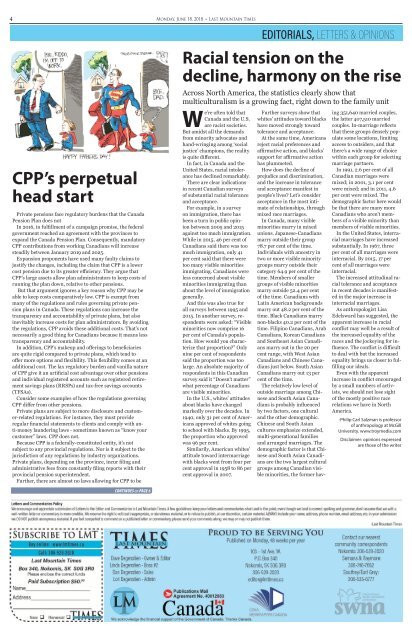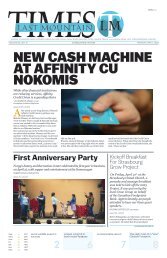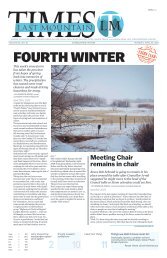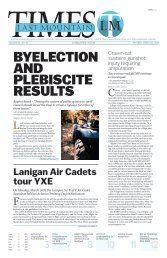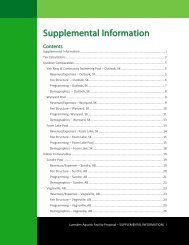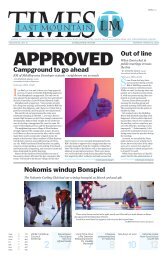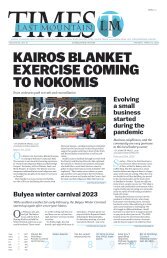Last Mountain Times June 18 2018
Create successful ePaper yourself
Turn your PDF publications into a flip-book with our unique Google optimized e-Paper software.
4 Monday, <strong>June</strong> <strong>18</strong>, 20<strong>18</strong> • <strong>Last</strong> <strong>Mountain</strong> <strong>Times</strong><br />
CPP’s perpetual<br />
head start<br />
Private pensions face regulatory burdens that the Canada<br />
Pension Plan does not<br />
In 2016, in fulfillment of a campaign promise, the federal<br />
government reached an agreement with the provinces to<br />
expand the Canada Pension Plan. Consequently, mandatory<br />
CPP contributions from working Canadians will increase<br />
steadily between January 2019 and 2025.<br />
Expansion proponents have used many faulty claims to<br />
justify the changes, including the claim that CPP is a lower<br />
cost pension due to its greater efficiency. They argue that<br />
CPP’s large assets allow plan administrators to keep costs of<br />
running the plan down, relative to other pensions.<br />
But that argument ignores a key reason why CPP may be<br />
able to keep costs comparatively low. CPP is exempt from<br />
many of the regulations and rules governing private pension<br />
plans in Canada. These regulations can increase the<br />
transparency and accountability of private plans, but also<br />
inevitably increase costs for plan administrators. By avoiding<br />
the regulations, CPP avoids these additional costs. That’s not<br />
necessarily a good thing for Canadians because it means less<br />
transparency and accountability.<br />
In addition, CPP’s makeup and offerings to beneficiaries<br />
are quite rigid compared to private plans, which tend to<br />
offer more options and flexibility. This flexibility comes at an<br />
additional cost. The lax regulatory burden and vanilla nature<br />
of CPP give it an artificial cost advantage over other pensions<br />
and individual registered accounts such as registered retirement<br />
savings plans (RRSPs) and tax-free savings accounts<br />
(TFSAs).<br />
Consider some examples of how the regulations governing<br />
CPP differ from other pensions.<br />
Private plans are subject to more disclosure and customer-related<br />
regulations. For instance, they must provide<br />
regular financial statements to clients and comply with anti-money<br />
laundering laws - sometimes known as “know your<br />
customer” laws. CPP does not.<br />
Because CPP is a federally-constituted entity, it’s not<br />
subject to any provincial regulations. Nor is it subject to the<br />
jurisdiction of any regulations by industry organizations.<br />
Private plans, depending on the province, incur filing and<br />
administrative fees from constantly filing reports with their<br />
provincial pension superintendent.<br />
Further, there are almost no laws allowing for CPP to be<br />
CONTINUES on PAGE 6<br />
EDITORIALS, LETTERS & OPINIONS<br />
Racial tension on the<br />
decline, harmony on the rise<br />
Across North America, the statistics clearly show that<br />
multiculturalism is a growing fact, right down to the family unit<br />
We’re often told that<br />
Canada and the U.S.<br />
are racist societies.<br />
But amidst all the demands<br />
from minority advocates and<br />
hand-wringing among ‘social<br />
justice’ champions, the reality<br />
is quite different.<br />
In fact, in Canada and the<br />
United States, racial intolerance<br />
has declined remarkably.<br />
There are clear indications<br />
in recent Canadian surveys<br />
of substantial racial tolerance<br />
and acceptance.<br />
For example, in a survey<br />
on immigration, there has<br />
been a turn in public opinion<br />
between 2005 and 2015<br />
against too much immigration.<br />
While in 2015, 46 per cent of<br />
Canadians said there was too<br />
much immigration, only 41<br />
per cent said that there were<br />
too many visible minorities<br />
immigrating. Canadians were<br />
less concerned about visible<br />
minorities immigrating than<br />
about the level of immigration<br />
generally.<br />
And this was also true for<br />
all surveys between 1995 and<br />
2015. In another survey, respondents<br />
were asked: “Visible<br />
minorities now comprise 16<br />
per cent of Canada’s population.<br />
How would you characterize<br />
that proportion?” Only<br />
nine per cent of respondents<br />
said the proportion was too<br />
large. An absolute majority of<br />
respondents in this Canadian<br />
survey said it “Doesn’t matter”<br />
what percentage of Canadians<br />
are visible minorities.<br />
In the U.S., whites’ attitudes<br />
about blacks have changed<br />
markedly over the decades. In<br />
1940, only 31 per cent of Americans<br />
approved of whites going<br />
to school with blacks. By 1995,<br />
the proportion who approved<br />
was 96 per cent.<br />
Similarily, American whites’<br />
attitude toward intermarriage<br />
with blacks went from four per<br />
cent approval in 1958 to 86 per<br />
cent approval in 2007.<br />
Further surveys show that<br />
whites’ attitudes toward blacks<br />
have moved strongly toward<br />
tolerance and acceptance.<br />
At the same time, Americans<br />
reject racial preferences and<br />
affirmative action, and blacks’<br />
support for affirmative action<br />
has plummeted.<br />
How does the decline of<br />
prejudice and discrimination,<br />
and the increase in tolerance<br />
and acceptance manifest in<br />
people’s lives? Let’s consider<br />
acceptance in the most intimate<br />
of relationships, through<br />
mixed race marriages.<br />
In Canada, many visible<br />
minorities marry in mixed<br />
unions. Japanese-Canadians<br />
marry outside their group<br />
78.7 per cent of the time.<br />
Individuals with ancestry in<br />
two or more visible minority<br />
groups marry outside their<br />
category 64.9 per cent of the<br />
time. Members of smaller<br />
groups of visible minorities<br />
marry outside 52.4 per cent<br />
of the time. Canadians with<br />
Latin American backgrounds<br />
marry out 48.2 per cent of the<br />
time. Black Canadians marry<br />
non-blacks 40.2 per cent of the<br />
time. Filipino Canadians, Arab<br />
Canadians, Korean Canadians<br />
and Southeast Asian Canadians<br />
marry out in the 20 per<br />
cent range, with West Asian<br />
Canadians and Chinese Canadians<br />
just below. South Asian<br />
Canadians marry out 13 per<br />
cent of the time.<br />
The relatively low level of<br />
outside marriage among Chinese<br />
and South Asian Canadians<br />
is probably influenced<br />
by two factors, one cultural<br />
and the other demographic.<br />
Chinese and South Asian<br />
cultures emphasize extended,<br />
multi-generational families<br />
and arranged marriages. The<br />
demographic factor is that Chinese<br />
and South Asian Canadians<br />
are the two largest cultural<br />
groups among Canadian visible<br />
minorities, the former having<br />
351,640 married couples,<br />
the latter 407,510 married<br />
couples. In-marriage reflects<br />
that these groups densely populate<br />
some locations, limiting<br />
access to outsiders, and that<br />
there’s a wide range of choice<br />
within each group for selecting<br />
marriage partners.<br />
In 1991, 2.6 per cent of all<br />
Canadian marriages were<br />
mixed; in 2001, 3.1 per cent<br />
were mixed; and in 2011, 4.6<br />
per cent were mixed. The<br />
demographic factor here would<br />
be that there are many more<br />
Canadians who aren’t members<br />
of a visible minority than<br />
members of visible minorities.<br />
In the United States, interracial<br />
marriages have increased<br />
substantially. In 1967, three<br />
per cent of all marriages were<br />
interracial. By 2015, 17 per<br />
cent of all marriages were<br />
interracial.<br />
The increased attitudinal racial<br />
tolerance and acceptance<br />
in recent decades is manifested<br />
in the major increase in<br />
interracial marriages.<br />
As anthropologist Lisa<br />
Edelsward has suggested, the<br />
apparent increase in racial<br />
conflict may well be a result of<br />
the increased equality of the<br />
races and the jockeying for influence.<br />
The conflict is difficult<br />
to deal with but the increased<br />
equality brings us closer to fulfilling<br />
our ideals.<br />
Even with the apparent<br />
increase in conflict encouraged<br />
by a small numbers of activists,<br />
we should not lose sight<br />
of the mostly positive race<br />
relations we have in North<br />
America.<br />
-Philip Carl Salzman is professor<br />
of anthropology at McGill<br />
University. www.troymedia.com<br />
Disclaimer: opinions expressed<br />
are those of the writer


